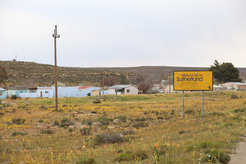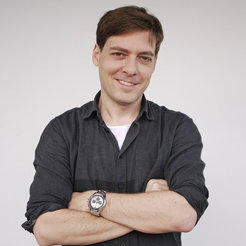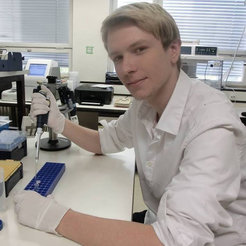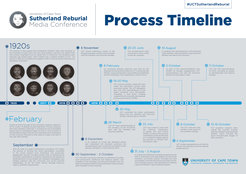Addressing injustice with the science of human history
Dr. Stephan Schiffels and Joscha Gretzinger use genetic analysis to help restore dignity to unethically obtained skeletons in South Africa

In February of 2017, Dr. Victoria Gibbon, curator of human remains and senior lecturer from the University of Cape Town’s Department of Human Biology, was conducting an archiving audit of the university’s skeletal collection.
Amidst a push in South Africa to establish a process for distinguishing ethically procured human remains in universities and museums from unethical ones, Dr. Gibbon was about to embark on an investigation that could set national precedent for future reburial and restitutions.
Amongst the more than 1000 skeletons in the collection, Dr. Gibbon discovered, were 11 that should not have been there. Nine of the skeletons, seven adults and two children, were brought to UCT by a medical student in the 1920s from Kruisrivier farm in nearby Sutherland. The scant records that accompanied the donations contained first names for six of the individuals, sporadic pieces of information suggesting familial relationships and causes of death, and two surnames: Abraham and Stuurman.
Six of the individuals were described as San, three as Khoe – peoples who inhabited the Sutherland region prior to European colonization and who have faced waves of oppression in the centuries since.
After the discovery, a moratorium was immediately placed on the remains. Dr. Gibbon, along with Deputy Vice Chancellor of Transformation Professor Loretta Harris and public participation advisor Doreen Februarie, began a process of locating and communicating with the families of the deceased, seeking their input and wishes for the treatment of the skeletons.
The process would come to involve seven teams collaborating from three research institutions, each contributing their specialties to piece together the history of these individuals and restore them to their communities.
Genetic analysis answers pressing questions
Some 12,000 kilometers north of Cape Town, Dr. Stephan Schiffels, research group leader for the Department of Archaeogenetics at the Max Planck Institute for the Science of Human History in Jena, Germany, was also seeking answers from human remains.
Over the past few years, his research into population genetics had prompted studies in Africa, Australia, Europe, North America, and Siberia, each providing insight into the region’s population and peopling. But when Dr. Gibbon contacted him to conduct DNA analysis on the remains of the nine individuals from Sutherland, he knew this would be a different sort of project.

“As far as the science was concerned, this was similar to work we’ve done many times before. It was a forensics job, more or less,” says Schiffels. “But on a personal level, this was something entirely different. I mean, we knew their names. We were asked to do this work by the descendants of the individuals we were studying, and I knew that our findings would carry a different weight, have a different impact, than the results we are used to publishing.”
To perform the requested analysis, Schiffels recruited the help of PhD student Joscha Gretzinger, a skilled lab technician and analyst.
“We were essentially trying to answer three questions,” Gretzinger explains. “We wanted to determine the genetic sex of each individual, to find out whether any of them were related to one another, and to find out whether the ancestry of these individuals matched that of other present-day people in South Africa or any other African populations in our reference database.”
Because the analysis was part of a larger process of restoring these nine individuals to their communities, Schiffels and Gretzinger were asked to preserve as much of the tissue as possible while extracting the necessary samples.
“That was one of the things that made this project different than others I’ve worked on,” says Gretzinger. “Normally we would have liked to sample the teeth of the individuals again, but thankfully we were able to get all the data we needed from one extraction.”

Of the adults, genetic analysis identified two as female and five as male. Two individuals, Klaas and Saartje, were second-degree relatives, which is consistent with half-siblings or double cousins. A third individual, Jannetje, was a third-degree relative, likely a first cousin, of both Klaas and Saartje.
Of the children, analysis showed one to be male and the other female. They were not closely related to each other or to any of the adult individuals with whom they were buried or exhumed.
The results of mitochondrial DNA analysis confirmed that all nine individuals are from the L0d Haplogroup, consistent with San and Khoe people in southern Africa. Nuclear DNA analysis was successful for seven of the individuals, all of whom clustered with Tuu speakers.
“Because most of my work deals with European populations, doing genetic analysis in South Africa was a bit different,” says Gretzinger. “I got to use databases that I usually don’t, and it was cool to work on a project that really reaches the people and has meaning for the population.”
“I’ve never seen a project like this,” Schiffels adds. “Dr. Gibbon and her colleagues were actually able to track down the descendants of people who died 150 years ago, restore justice to the deceased, and do something really meaningful for the descendants. I knew it was something I should be a part of.”
Working on a project of such great importance to so many people was not without its challenges, however.
“Our analysis showed that the samples from at least two of the individuals were quite severely contaminated,” says Schiffels, “but when we shared that with our partners in South Africa – not all of whom were experts in DNA – we noticed several people reacting to that word, contaminated.”
Sometimes so little genetic material is preserved in human remains that the few molecules of DNA remaining can easily be overwhelmed by genetic material from other sources, such as bacteria transmitted through a breath or skin cells floating on dust. This outside genetic material is called contamination, which scientists can estimate during analysis.
“We later found out through Dr. Gibbon that some people briefly thought we were commenting on the race or ancestry of the individuals, distinguishing ‘racially pure’ remains from ‘racially contaminated’ ones, which is certainly not what we intended. DNA shows us that the notion of a pure race is complete fiction, but history shows us that the impacts of belief in such a fiction are frighteningly real.”
For Schiffels, projects like this are becoming more and more important.
“Good science is not just doing ingenious new things with data, although that certainly is important,” he says. “Really good science has to do more than that - it has to be able to communicate with the public. And that’s something we’re all still learning.”
A journey towards dignity
For the descendants of the individuals from Sutherland, the goal of this journey was always restitution. Scientific research was just part of the process that made it possible.
“This is about restoring the dignity of our ancestors,” said Mr. Anthony Mietas, representative of the Stuurman and Abraham families, at a UCT media conference in November, 2019. “At one point in our lives we are all confronted with the questions: Who are we? Where do we come from? What is our heritage? This is as a result of a brutal system called apartheid in South Africa.”
“These remains give all South Africans a connection to a past that colonialism and apartheid tried to ignore,” Professor Mamokgethi Phakeng, vice-chancellor of the University of Cape Town, wrote to students and staff of UCT. “They provide affirmation that this is African land, our history, our heritage; that our future belongs to us as much as our past. They also show us that South Africans each have their own story, their own heritage, connected by DNA and by the memories that individuals keep alive.”
Reburial of the nine individuals will take place in early 2020. Not at Kruisrivier farm, but at a historic cemetery in Sutherland where members of the community can come and visit them, finally laid to rest.




